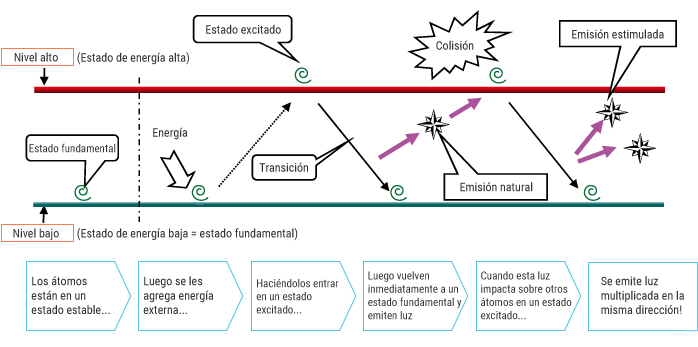Principles of the laser – Elena
What is the light?
Light is a type of “electromagnetic wave.” “Electromagnetic waves” follow a “wavelength” standard and, starting with longer waves, can be classified into radio waves, infrared rays, visible rays, ultraviolet rays, X-rays and gamma rays.
What is the color?
When the wavelengths of light affect an object, those that are reflected without being absorbed by the object are captured by the human eye (retina). When this occurs, we recognize these wavelengths as the “color” of the object. The index of refraction varies according to the wavelength, therefore, the light is divided. As a result, we are able to recognize a wide variety of “colors.” For example, an apple (under daylight, which includes specific light rays that allow humans to see the color red) reflects the wavelengths of red light (600 to 700 nm) and absorbs all other wavelengths of the light. * Black objects absorb all light and look black.
What is visible light?
Electromagnetic waves that are within the range of wavelengths that humans can see are called “visible rays.” In other words, on the short wavelength side, visible rays measure from 360 to 400 nm, and measure from 760 to 830 nm on the long wavelength side. Wavelengths that are shorter or longer than “visible rays” are not visible by the human eye.
Differences between ordinary light and lasers
This is where regular lights (lamps, etc.) and lasers differ. Because lasers emit light beams with high directivity, which means that the light waves that compose them travel together in a straight line, almost without dispersing. Common light sources emit light waves that scatter in all directions. But the light waves in a laser beam are all the same color . Ordinary light (like the light of a fluorescent bulb) is generally a mixture of several colors, which combine and appear white.
As the light waves travel in a laser beam, they oscillate with their peaks and valleys in perfect synchronization, a characteristic known as coherence. When two laser beams overlap each other, the peaks and valleys of the light waves in each beam reinforce each other, to generate an interference pattern.
Etymology of the laser
The term “laser” originated as an acronym for “light amplification by stimulated emission of radiation”.
Principles of the laser
When atoms (molecules) absorb external energy, they pass from a low level (low energy state) to a high level (high energy state). This state is an exciting state.
This state of excitation is one that is unstable and in it, the atoms will try to return immediately to a state of low energy. This is transition.
When this occurs, a light is emitted that is equivalent to the energy difference. This phenomenon is a natural emission. The emitted light collides with other atoms that are in a similar excited state, which induces a transition in the same way. This light that has been induced to emission is called stimulated emission.

Laser types
Have three types lasers: solid state, gas and liquid.
The optimal type of laser will differ depending on the processing application.
Solid state
Nd: YAG
- YAG (yttrium and aluminum garnet)
Standard wavelength (1064 nm)General Purpose Marking
Second harmonic (532 nm) (green laser)Soft marking on silicon wafers, etc.
Used for marking and detailed processing
Third harmonic (355 nm) (UV laser)Ultra-detailed processing commonly users it, such as LCD marking, repair processing and VIA holes
Liquid crystal repair processing: cutting the coating pattern during repairs
VIA hole processing: PCB hole drilling
- YAG laser (Nd: YAG)
- YAG lasers are used for general purpose marking and for processing such as marking and trimming, not only of plastic materials, but also of metals. With an infrared light wavelength close to 1064 nm, so the human eye can’t see these lasers.
YAG is a crystalline structure of yttrium (Y), aluminum (A) and garnet (G). By doping a light emitting element, in this case the neodymium ion (Nd), the YAG crystal will enter into a state of excitation through the light absorption of a lamp or laser diode.
- Nd: YVO4 (1064 nm)
- YVO 4 (yttrium vanadate)
-
-
- Small character marking
- High peak power at high frequencies of Q-switch
Good energy conversion efficiency
-
- YVO4 laser (Nd: YVO4)
- Commonly detailed marking applications user YVO4 lasers, such as small character marking and other processing tasks. With a wavelength of light similar to that of the YAG laser (1064 nm), the human eye cannot see the YVO4 laser.
YVO4 lasers are solid lasers with a crystalline structure of yttrium (Y), vanadium (V) and oxide (O4). When this structure is doped with a neodymium ion light emitting element (Nd), the application of LD light at one end of the structure creates a state of excitation.
- Yb: Fiber (1090 nm)
- Yb (ytterbium)
-
-
- High power marking
- Extremely wide amplification medium surface area for easy high power
In order to make miniaturization possible, high cooling efficiency and simplified cooling mechanisms
-
- LD (650 a 905 nm)
-
- Semiconductor laser (GaAs, GaAlAs, GaInAs)
Gas
- CO2 (10.6 μm)
-
- Processing machines, marking applications, laser peeling
- CO2 laser
- CO2 lasers for processing machinery and marking.
But with an infrared light wavelength of 10.6 μm, the human eyethese lasers cannot see them. CO2 lasers include not only CO2 gas inside the fully sealed oscillation tube, but also specific amounts of N2 (nitrogen) and He (helium).
This feature gives CO2 lasers the nickname of “sealed type” lasers. Nitrogen (N2) increases CO2 energy, while helium (He) constantly reduces energy to a more stable state.
- He-Ne standard (630 nm)
-
-
- Measurement systems (profile measurement, etc.)
- This is the most popular type of laser.
Because the low output power, commonly profile measurements users these lasers.
-
- Excimer (193 nm)
-
-
- Semiconductor exposure equipment, eye care
- The excimer lasers generate light with a relatively simple structure, which mixes inert gas with halogen gas.
Besides, like a deep ultraviolet laser (DUV), the absorption rate is incredibly high.
-
- Argon (488 to 514 nm)
-
-
- Scientific applications
- Available in a variety of colors, argon lasers are mainly used in laboratories, such as biotechnology laboratories.
-
Liquid
- Colorant (330 to 1300 nm)
-
-
- Scientific applications
- The use of laser light to excite the dye produces a fluorescence thereof.
more information please click: www.xtlaser.com
-



